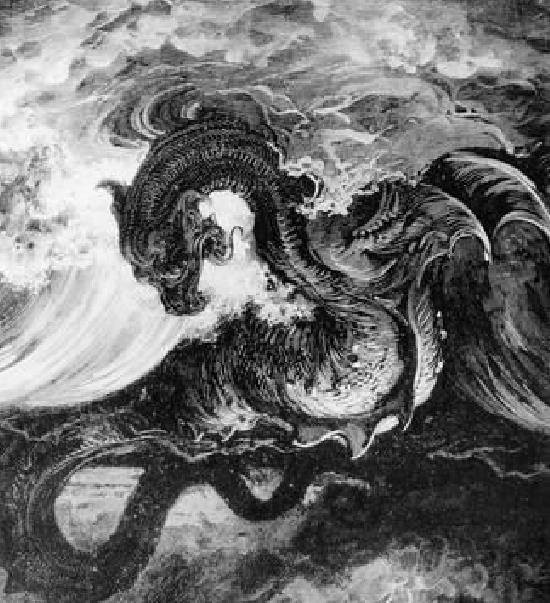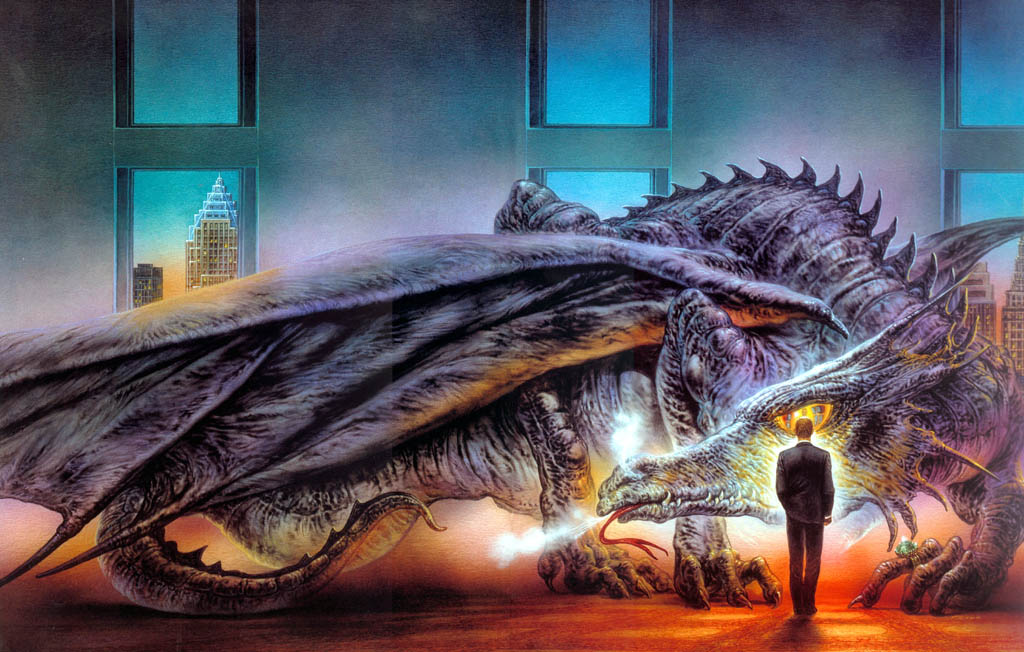
by Lewis Pulsipher

If we believe our fantasy traditions, dragons
and demons are
the most dangerous creatures alive, except
for men. Unfortunately,
this is only half true in the DUNGEONS
& DRAGONS®
and ADVANCED
DUNGEONS & DRAGONS™ games. A large
dragon is fearsome, no doubt about it,
but a high-level magicuser
or two can usually defeat one — not only
defeat it, but gain
control of it. This rarely happens to
demons, and as much as I
enjoy riding a charmed or magic-jarred
dragon, I don’t think
such a thing should happen to them, either.
A simple solution would be to give dragons
magic resistance,
say 10% per age category up to 80% for
Ancient. Unfortunately,
this makes dragons too formidable, for
their large numbers of hit
points and especially their fearsome breath
weapons make
them almost unbeatable physically unless
one is found asleep.
We could reduce the damage caused by dragon’s
breath, but
that’s still far from perfect. Not only
do dragons seem too tough
physically and not tough enough magically,
the D&D® and
AD&D™ dragons lack character.
The dragon of fantasy is almost
always rare, each one unique, each with
a distinctive personality.
Too often, D&D and AD&D
dragons are faceless monsters
from the assembly line, sometimes found
in amazingly large
numbers.
There’s nothing for it but to keep the
old dragon as is, for it is a
useful monster, and make up a new type
of monster which is the
equal of demons and devils, as dragons
ought to be. One such
version of “true dragons” follows.
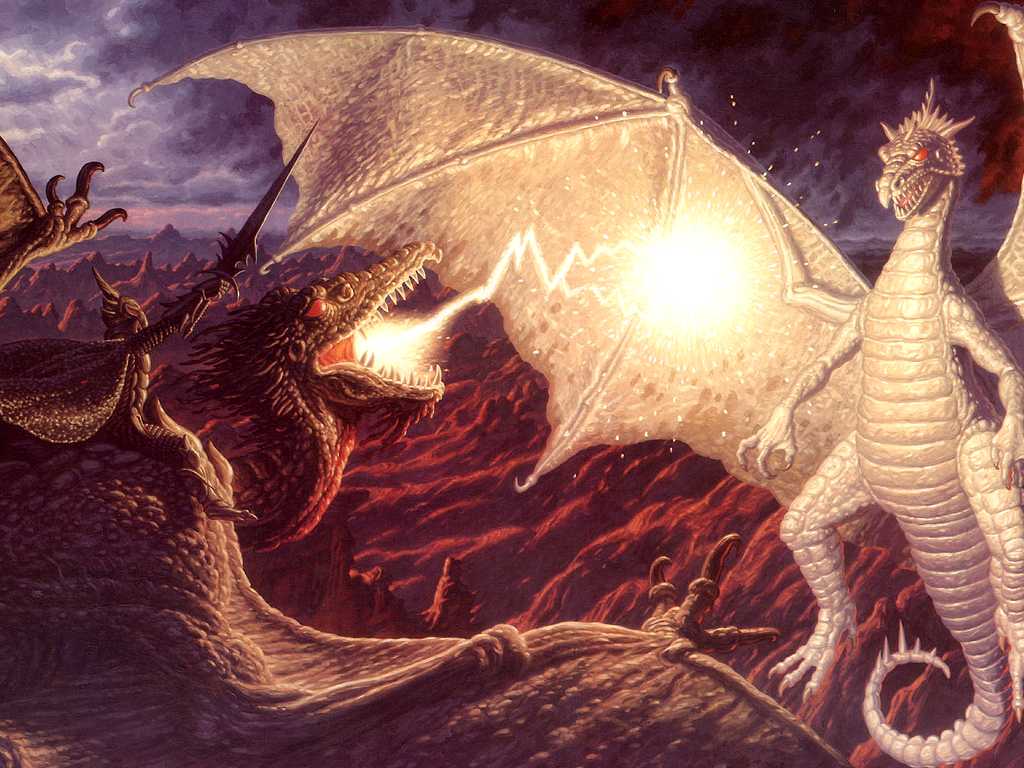
Age and related characteristics
Each dragon has several unique characteristics
— no two
dragons are ever the same. However, there
are common physiological
characteristics which depend on the dragon’s
age. Roll
percentile dice and consult the following
table to determine
them. A dragon grows throughout its natural
life. Hit points and
magic resistance increase, armor class
improves, size and the
damage inflicted by teeth and claws also
increase. Other characteristics
change as shown on the table. (Note: When
HP
are rolled for a dragon any die result of 1 is disregarded and that die
is rolled again.)
| Dice roll | Age | HD | AC | Magic to hit | Move | Bite/Claws | % Sleep chance |
| 01-09 | 1-10 | 1 | 7 | - | 6/12 | 1-6/1/1 | 25 |
| 10-16 | 11-20 | 2 | 6 | - | 6/15 | 1-8/1/1 | 20 |
| 17-23 | 21-30 | 3 | 5 | - | 9/18 | 1-10/1/1 | 15 |
| 24-30 | 31-40 | 4 | 4 | - | 9/21 | 2-12/1-3/1-3 | 10 |
| 31-37 | 41-50 | 5 | 3 | - | 12/24 | 2-12/1-3/1-3 | 10 |
| 38-44 | 51-60 | 6 | 2 | +1 | 12/27 | 2-12/1-3/1-3 | 10 |
| 45-51 | 61-70 | 7 | 1 | +1 | 12/30 | 3-18/1-4/1-4 | 10 |
| 52-58 | 71-80 | 8 | 0 | +1 | 12/30 | 3-18/1-4/1-4 | 10 |
| 59-65 | 81-90 | 9 | -1 | +1 | 12/33 | 3-18/1-4/1-4 | 10 |
| 66-72 | 91-100 | 10 | -2 | +2 | 12/33 | 4-24/1-6/1-6 | 5 |
| 73-90 | 101-200 | 11 | -3 | +2 | 12/36 | 4-24/1-6/1-6 | 5 |
| 91-97 | 201-300 | 12 | -4 | +3 | 12/36 | 5-30/1-6/1-6 | 10 |
| 98-99 | 301-400 | 13 | -5 | +3 | 12/30 | 6-36/1-8/1-8 | 15 |
| 00 | 401+ | 14 | -6 | +4 | 12/30 | 7-42/1-8/1-8 | 20 |
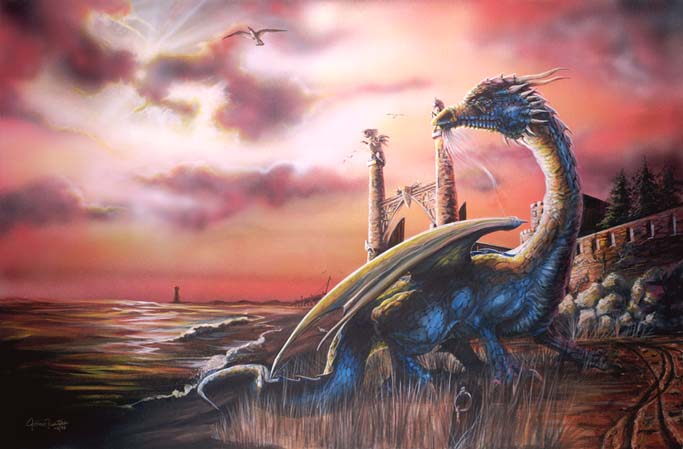
Size. Although
a dragon’s number of HD is a direct consequence
of its age, its physical size varies somewhat
within each
age group. Its wingspan and total length
(head to tail) are roughly
equal to each other. Its length is roughly
5-10 centimeters
(d6+4) per year of age; but even a newborn
dragon is at least a
meter (100 cm) long, so very young ones
are larger than this
calculation indicates. The length of the
tail is about one fifth of
the total length, giving dragons long,
sinuous bodies. The legs
are short, so the height isn’t much greater
than the diameter of
the body cavity. The head may be carried
up to three times body
height. Any dragon more than two meters
long is treated as
larger than man-size.
For example, a percentile
dice roll of 54 indicates a dragon
71-80 years old. A d10 roll
yields a 6, so the dragon is 76. A d6 roll
yields a 2, so the dragon
is 6 cm long per year, or roughly 4½
meters (c. 15 feet). The
wingspan is the same. The tail is 90 cm
(c.3 feet) long. The maximum
body diameter is 90 cm, the height
about 110-120 cm, and the
maximum height of the head when
raised is about 3-3½
meters.
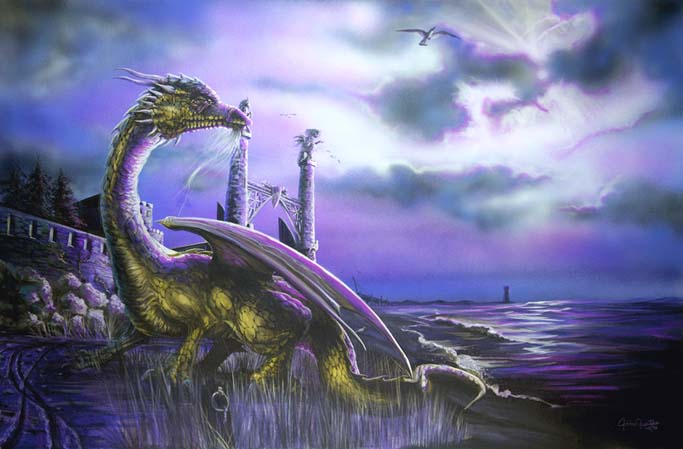
Movement.
Dragons, like large birds, soar during most of their
flights, consequently preferring country
where thermals and
other updrafts are common — in mountains,
near large lakes,
and so on. Their ungainly bodies usually
make them slow afoot,
even when (as often happens) they have
more than two pairs of
legs.
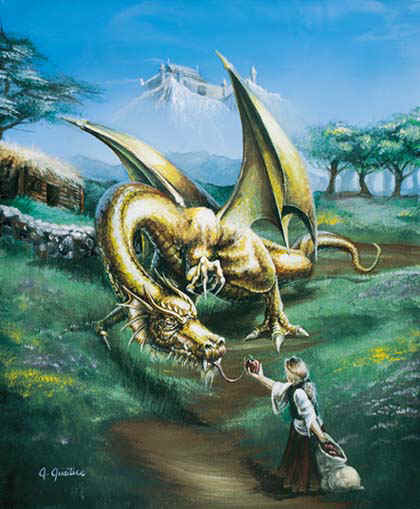
Attacks.
A dragon’s physical attack capability improves as it
grows, of course. Values are indicated
on the table above.
In addition, one dragon in 10 can attack
with its tail. This
attack is equal in effect to a claw attack.
The tail’s attack comes
from directly over the dragon’s head;
the tail cannot be used for
this purpose while the dragon flies.
One dragon in 100 can also launch spines from its tail. Treat the creature as a manticore for this purpose.
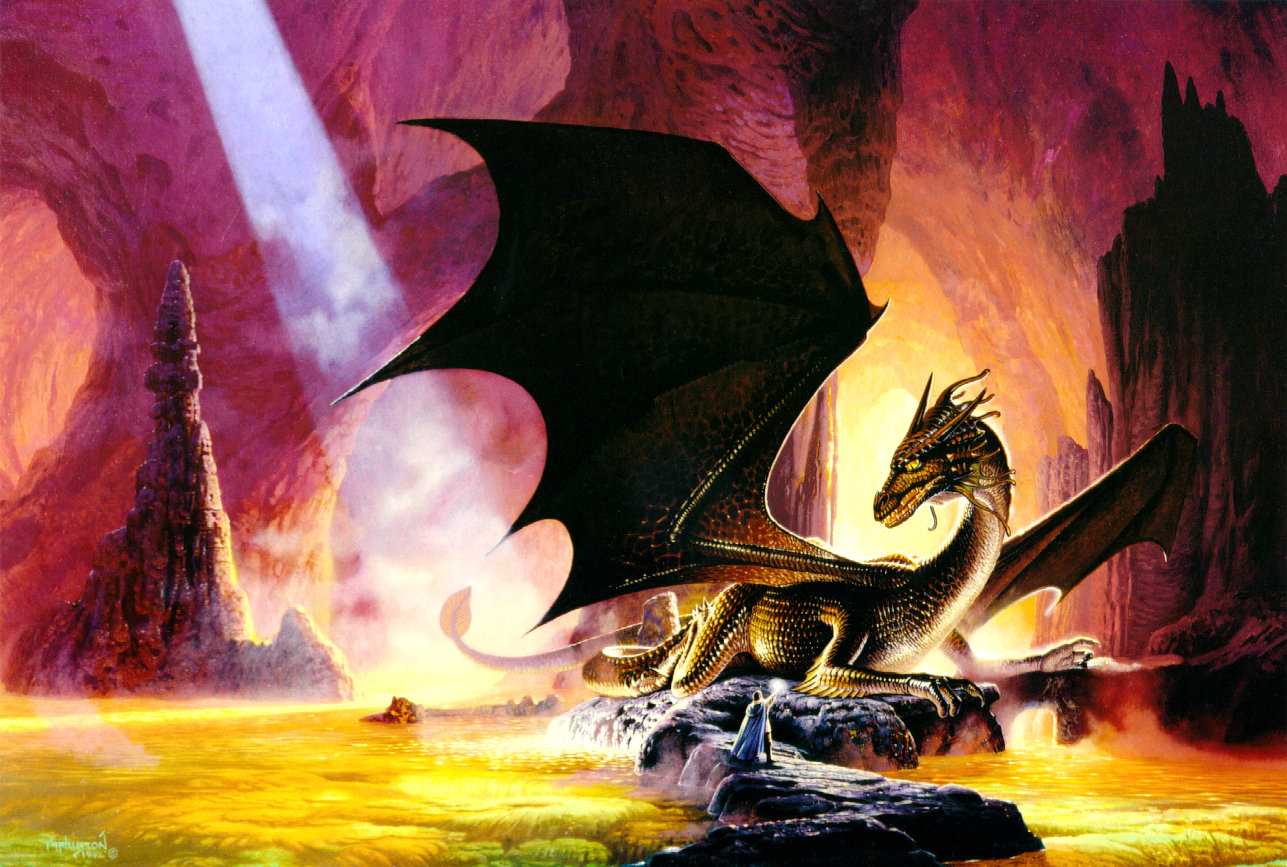
Magic Resistance.
Every dragon has some magic resistance,
as defined in the Monster Manual
— that is, resistance varies
with the spell caster’s level. Magic resistance
increases with age,
equaling 10% per hit die up to 90% for
dragons of nine or more
hit dice. Even a one-hit-die dragon (10%
MR) is unlikely to be
susceptible to a spell cast by a first-level
magic-user, since the
magic-resistance calculations yield an
effective resistance of
60% to spells cast by a character of that
level.
Dragons are not affected by the Sleep
spell, nor in any way by
the Magic Jar spell. They cannot be Charmed
or Held unless the
spell-caster speaks the dragon’s True
Name as he casts the
spell. The same applies to any other control
device except
dragon-control potions. if the user of
a dragon-control potion
knows the dragon’s True Name, the beast
gets no saving throw.
Don’t forget the dragon’s magic resistance,
however.
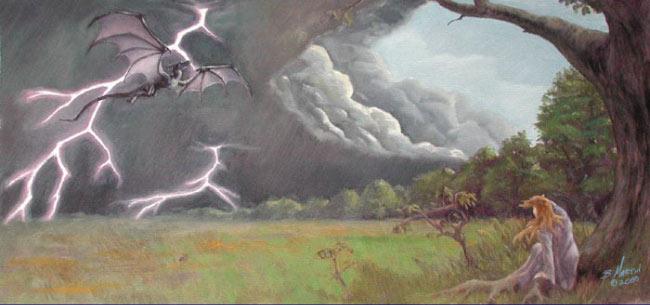
Saving throws.
Dragons make saving throws as fighters
or magic-users, whichever is most favorable,
with hit dice equating to level.
They are allowed two saving throws against
poison, and
a massive dose of any poison must be administered
to have any
chance of affecting the dragon.
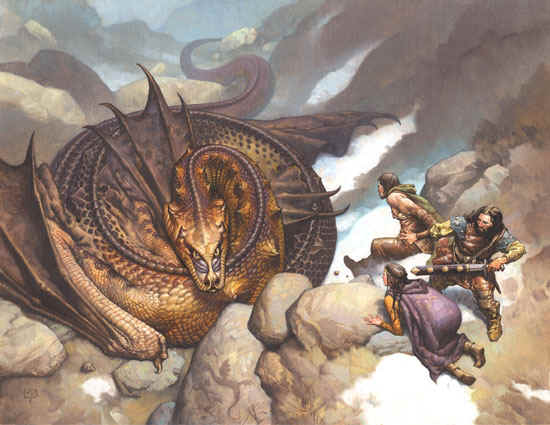
Perceptions.
An older dragon’s sense perceptions are much
stronger than a human’s. It is difficult
to express this quantitatively.
Roughly, senses are as follows:
Age 1-20: Sight, smell, taste, hearing
roughly human
equivalent.
Age 21-50: Sight and hearing roughly equivalent,
smell two
times human sensitivity, taste acute;
detects foreign addition to
food (such as poison) 10% better than
a human could.
Age 51-100: Sight two times human sensitivity
(for both
distance and detail), hearing two times
human, smell three times
human, taste 20% better than human at
detecting foreign material.
Can detect hidden or invisible enemies
25% of the time.
Age 101 or above: Sight
and hearing three times human,
smell five times human, taste 50% better
than human, detects
hidden or invisible enemies 50% of the
time. (At age 201 this
increases to 75%.)
Dragons see equally well in darkness and
in light, but shadows
can confuse them — consequently, thieves
may hide in shadows.
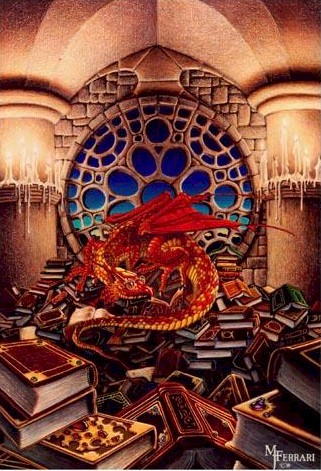
Shapechanging.
Few dragons can actually change shape, but
many can seem to do so. The “shapechanging”
power increases
with age.
At age 1-20 the dragon may create an immobile
phantasmal
force around itself, appearing as some
other creature. If the
dragon moves the phantasm will be broken,
of course, and the
creature so portrayed must be approximately
as large, or larger
than, the dragon itself.
At age 22-50 the dragon can move the force
along with itself,
but if it attacks the illusion is broken.
At age 51-100 the dragon can create an
illusion (similar to that
projected by a wand) to cover its true
form. The illusionary
creature may be as small as half the dragon’s
size.
At age 101-250 the dragon can create a
similar illusion but
with components of smell, touch, and sound—to
normal tests it
will seem real. At the same time, the
dragon’s own scent will be
undetectable. Of course, the dragon must
still keep its own bulk
out of the way, yet still contiguous with
the illusion — not an
easy task. If the dragon attacks, the
illusion is dispelled.
At age 251-400 the dragon can also polymorph,
itself into
human or near-human form. Old men and
beautiful women are
most favored.
Finally, at age 401 or more the dragon
can shapechange, as
the ninth-level magic-user spell.
These powers may be used once per day each.
The older
dragons have all the powers of the younger
ones, of course. The
dragon must devote much of its attention
to the phantasmal or
illusionary powers, so it cannot attack
or use other special
powers while masking its true shape. These
innate powers are
not magic spells, but Dispel
Magic may affect or dispel them.
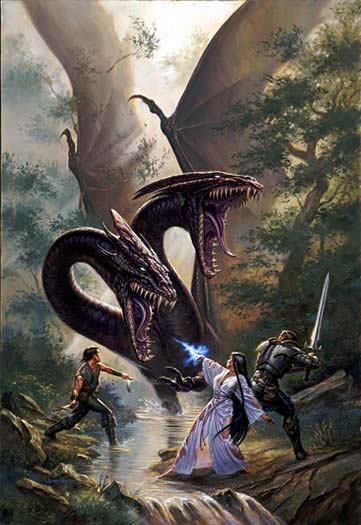
Terror. A dragon
is a fearsome creature of lejend, not a
familiar commonplace. People react to
the proximity of a dragon
with fear and awe. Reaction depends on
whether the dragon <semantic: awe>
is ignoring or unaware of the character,
regarding him with
hostility, or acting hostilely (charging,
for example). A dragon
flying overhead, even if it is unaware
of the character reacting, is
treated as hostile or, if flying very
high, as regarding with hostility.
Record the saving throw result for each
character, since a
number sufficient to save in one case
may be insufficient in a
more serious case, and the same number
is used throughout.
The number needed to save is derived from
the dragon’s hit
dice (HD).
Terror Save Table (D20)
Dragon’s Attitude
| Character
Level |
Ignoring/Unware | Regarding | Hostile |
| 0 level/
normal |
HD+2 | HD+4 | 20 |
| 1-2 | HD-2 | HD | HD+4 |
| 3-5 | HD-7 | HD-3 | HD+2 |
| 6-9 | HD-10 | HD-5 | HD |
Characters of 10th level and above are
unaffected. A 20 is
always a save, but in some cases even
a 1 is enough to save—for
example, an “unaware” dragon of 7 hit dice
yields a “need to
save” number of zero for third-to fifth-level
characters, so even a
1 would be a save.
When more than one dragon is present, use
the largest dragon’s
number of hit dice as a base for calculation,
and subtract
one from the saving throw for each additional
dragon present
(or, add one to the number needed to save).
If a character fails to save he will (75%
of the time) flee in terror
or (25%) stand paralyzed with fear for
1-4 rounds, then flee.
Fleeing continues until two rounds after
the dragon is out of
sight. If the dragon is flying above the
frightened character, he
may flee to a place of hiding.
In addition to being terrified; characters
may be so awestruck
that they will not attack the dragon unless
attacked first, and
even then the dragon will have the initiative.
A character is
awestruck if a roll of d20 is greater
than half the sum of his
intelligence, wisdom, and experience level.
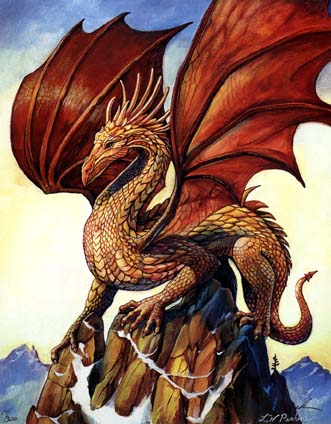
Special powers.
The genes for most of a dragon’s unusual
powers are present in every dragon. Chromosomes
may fit together
in several ways, and few traits of this
type are definitely
dominant or recessive, so almost any power
may show up in a
newborn dragon, regardless of its parents’
powers.
Each dragon possesses a distinctive special
power which,
however, it rarely uses. Roll on the Miscellaneous
Magic Item tables in the DMG and derive the dragon’s <UA>
power from the magic item which results.
For example, if you
roll Stone Controlling Earth Elementals,
then the dragon is able
automatically to take control of any earth
elemental in its
presence.
Some dragons also have more common special
powers. Roll
percentile dice for each dragon and consult
the following table:
| Dragon | Special Power |
| 01-55 | None |
| 56-65 | Awareness |
| 66-68 | Immortality |
| 69-73 | Magic resistance |
| 74-83 | Mesmerize |
| 84-88 | The Pearl |
| 89-93 | Speed |
| 94-98 | Water |
| 99-00 | Two heads |
A description of each power follows.
Awareness. The dragon is never
surprised. Its perceptions are
two categories higher than normal for
its age. At age 101 it
always detects hidden or invisible enemies.
Immortality. The dragon
will never die by natural means. (Of
course, few dragons live long enough to
die naturally anyway.)
Magic resistance. The dragon’s magic resistance is twice standard for its age.
Mesmerize. By modulations of its
speaking voice the dragon
can lull a listener — even (or especially)
one who thinks he is
hidden — until the dragon can make Suggestions(as
the third-level
magic-user spell). A save vs. magic is
permitted. Any
number of victims may be affected at the
same time.
The Pearl. The dragon’s “life essense,”
or soul, is housed in a
large pearl. If the dragon is killed it
reappears, at age 1, beside its
pearl two weeks after its death,
with its memories intact. On the
other hand, if the pearl is crushed the
dragon dies. Consequently,
someone who holds a dragon’s pearl can
force it into servitude,
though it is wiser to require a single
task of the dragon in
return for the pearl.
SPEED. The dragon moves on the ground twice as fast as normal for its age.
Water. The dragon
likes water and swims in it at half its flying
speed; breathing is similar to a whale’s.
(Normal dragons hate to
submerge themselves.)
Two heads.
The dragon has two heads, each with special
powers, breath weapons, and separate rolls for intelligence, wisdom,
ego, and interest in human affairs.
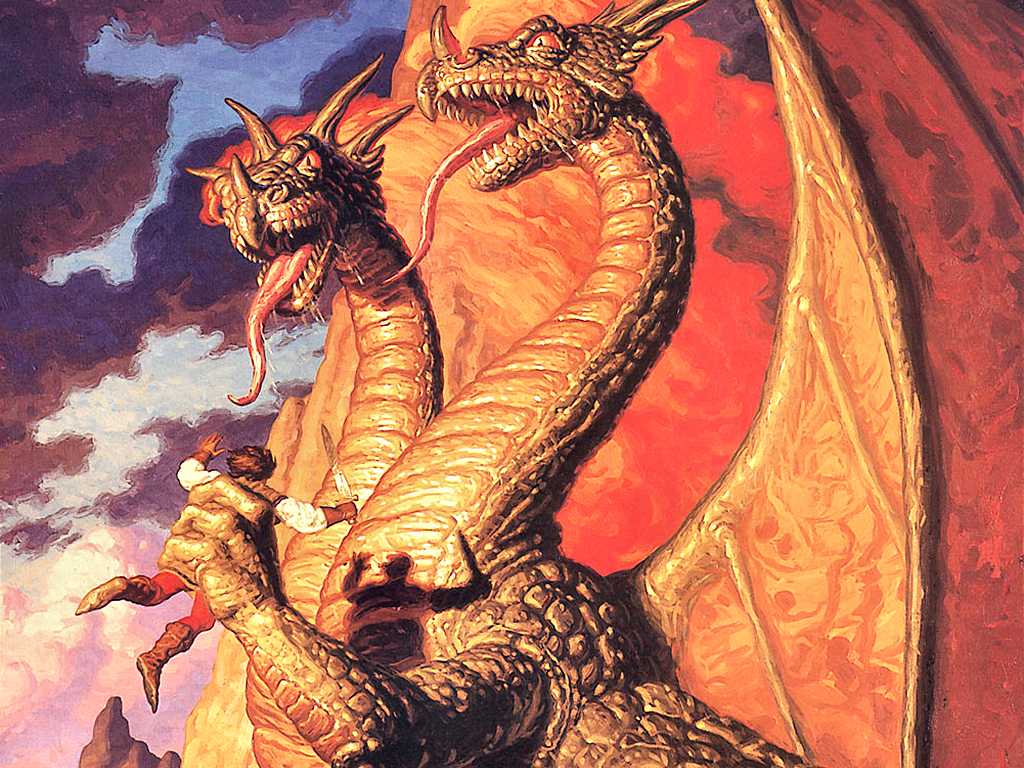
Breath weapon.
Every dragon has at least one breath weapon,
and 10% of all dragons have two, but in
90% of these cases the
second does not manifest itself until
the dragon reaches maturity
(11 hit dice). A dragon may use each breath
weapon 1-6 times
a day, but the total number of times cannot
exceed the number
of its hit dice. Breath weapons are not
magical. All saves are vs.
breath weapon unless otherwise specified.
Roll percentile dice to determine the breath
type(s). After
each one is listed the shape of the resulting
effect.
| - | Dragon breath |
| 01-10 | Acid — line |
| 11-16 | Chlorine gas — cloud |
| 17-18 | Cloudkill — cloud |
| 19-28 | Cold — cone |
| 29-48 | Fire — cone |
| 49-51 | Hallucinogen — cloud |
| 51-61 | Lightning — line |
| 62-63 | Negate magic - area |
| 64-65 | Paralysis gas — cloud |
| 66-68 | Polymorph — line |
| 69-70 | Radiation — area |
| 71-72 | Repulsion - cone |
| 73-77 | Slow gas — cloud |
| 78-80 | Sound — area |
| 81-95 | Stinking cloud — cloud |
| 96-98 | Stoning — cone |
| 99-00 | Windstorm — area |
The size of the AREA affected by a breath
weapon depends on
the hit dice of the dragon plus or minus
1d6 (50-50 chance of
addition or subtraction), referred to
in the following charts as
“Modified hit dice number.”
Cone. The breath
expands forward from the dragon’s mouth
in a cone shape. Roll once for length
and once for both
diameters:
Modified hit dice number
| - | 1 or less | 2-3 | 4-5 | 6-7 | 8-9 | 10-11 | 12-13 | 14+ |
| Initial diameter (width) | 1/8 | 1/8 | 1/4 | 1/4 | 1/2 | 1/2 | 1/2 | 1/2 |
| Final diameter (width) | 1 | 1½ | 2 | 2 | 3 | 3 | 3½ | 4 |
| Length | 4 | 5 | 6 | 7 | 7 | 8 | 8½ | 9 |
(All distances are in “inches.”)
Area. A spherical
area centered on the dragon’s mouth
is affected.
| - | 1 or less | 2-3 | 4-5 | 6-7 | 8-9 | 10-11 | 12-13 | 14+ |
| Radius | 1 | 1½ | 2 | 2½ | 3 | 4 | 5 | 6 |
Line. The breath
moves straight forward from the dragon’s
mouth in a line of width and length as
shown. Roll separately for
each dimension.
| - | 1 or less | 2-3 | 4-5 | 6-7 | 8-9 | 10-11 | 12-13 | 14+ |
| Length | 5 | 5½ | 6 | 6½ | 7 | 8 | 9 | 10 |
| Width | 1/8 | 1/8 | 1/4 | 1/4 | 1/2 | 1/2 | 1/2 | 3/4 |
Cloud. A cloud
forms at and moves away from the dragon’s
mouth. In most cases it dissipates in
the next melee round but in
a few cases it drifts with the wind
(if any); see explanations
below. The number given below is surface
diameter; height is
half as great.
| - | 1 or less | 2-3 | 4-5 | 6-7 | 8-9 | 10-11 | 12-13 | 14+ |
| Diameter | 2 | 2½ | 3 | 3½ | 4 | 4½ | 5 | 5½ |
Explanation of breath effects
Acid.
Does 1d4 points of damage per hit die of the dragon to
all within the area affected — half damage
if save is made. If acid
hits a large body directly it may splatter,
but it won’t move
further to the full length of the line;
in other words, it may be
blocked or intercepted by a large solid
mass.
Chlorine. Those failing to save
vs. poison take 8d6 poison
damage, regardless of the dragon’s
size, at a rate of 2d6 per
melee round.
Cloudkill. Effect and duration
is equivalent to a Cloudkill spell
(fifth-level M-U spell).
Cold. Does 1d4 of damage per hit
die of the dragon to each
victim — half damage if save is made.
Add one point to each
damage die vs. fire-using creatures and
subtract one point per
die (lowest) value is 1) vs. cold users.
Fire. Does 1d4 of damage
per hit die of the dragon to each
victim — half damage if save is made.
Add one point to each
damage die vs. cold-using creatures and
subtract one per die
(lowest value is 1) vs. fire users.
Hallucinogen.
Those failing to save experience multiple hallucinations
for the next 1-6 turns. The victim may
hear voices or
see things which don’t exist. He may even
think the damage is
something else. In general, he is unable
to undertake rational,
purposeful action.
Lightning.
Does 1d4 of damage per hit die of the dragon to all
in the line — half damage if save is made.
Negate magic. No magic spell or
spell-like power can work in
or traverse the area
of effect for the next five rounds.
Paralysis. Those failing to save
are paralyzed for the next 1-6
turns
Polymorph.
Those failing to save are polymorphed into frogs
(or another harmless creature).
Radiation.

Those failing to roll a d20 lower than
their constitution
become unconscious and will die of a wasting
“disease” in
1-4 days. The “disease” is cured by Cure
disease and Remove
curse. Effects of the disease are only
slowly repaired by the
body after the cure. A victim might look
ravaged five years after
his cure if he was near death, and this
may affect his charisma.
Repulsion. No save allowed. All
struck are forced away from
the dragon to the maximum range of the
cone of breath. The
dragon will probably try to pin its victims
against a wall or knock
them over a cliff.
Slow.
Those failing to save move at 50% speed and can attack
and cast spells only every other round
for the next 1-6 turns.
Sound. A massive thunderclap deafens
all within the affected
area for 1-6 turns. Those failing to save
take damage points
equal to four times the dragon’s hit dice
minus the victim’s own
CON.
A four-dice dragon, then, would do no damage to
someone with a 16 or higher constitution.
Those failing to save
twice are deafened permanently, as their
eardrums and inner
ears break.
Stinking cloud. Effect and duration
are equivalent to the
second-level magic-user Stinking
cloud spell.
Stoning. Those failing to save
are turned to stone.
Windstorm. This is equivalent to
an air elemental’s whirlwind.
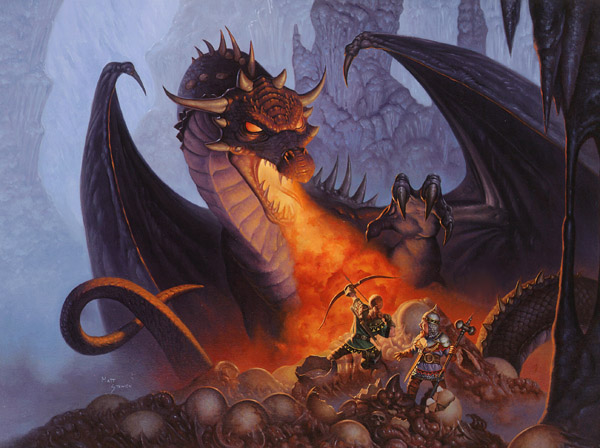
Dragon ability
numbers. Roll one d10 each for
the INT && WIS
of the dragon, adding one for each hit die.
Thus, both abilities increase with age.
Also roll 3d8 for the dragon’s
ego, adding one per hit die. Defining
the human ego range as
from 3 to 18, this result indicates how
egotistical dragons can be
a meek and mild dragon is truly rare.
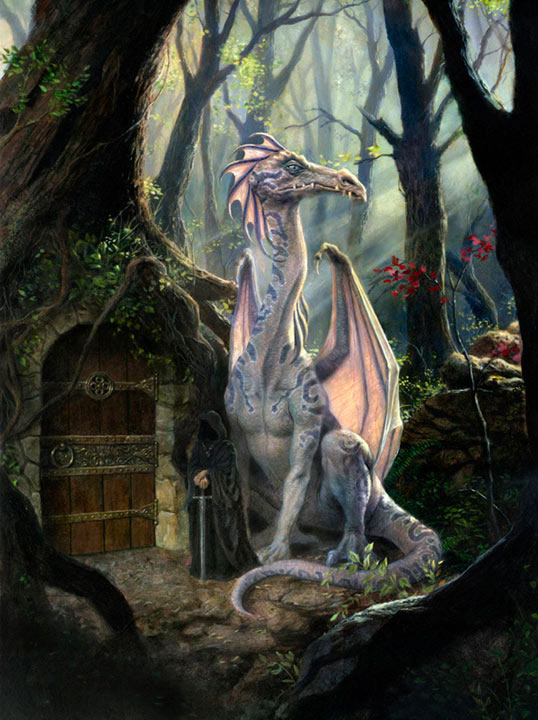
Spell Ability.
A dragon’s INT determines the
number
and Ievel of spells it can use, as shown
on the accompanying
table. However, a dragon can never know
more spells than the
number of its hit dice. In some cases
a dragon may even forget a
lower-level spell as it grows and gains
higher spells. Thus, a
10-dice dragon with 20 intelligence will
have 3-3-3-1 spells, even
though when he had 9 dice (and 19 intelligence)
his spells were
3-4-2.
Dragons do not use spell books; their spells
are randomly
selected from the list below, and they
may know only one spell
per spell-use capability. For example,
a dragon of 12 intelligence
knows exactly three first-level spells
and one secondlevel
spell, and no others.
For purposes of dispelling dragon spells
or defining spell
duration and power, the level of magic
use equals the dragon’s
hit dice.
Dragons are unable to use most magic items.
Generally only
those items which duplicate spells which
the particular dragon
can cast, and which present no physical
difficulties (a helm
won’t fit, for example) may be used.
In addition to any other spells, any dragon
can detect magic
(as the clerical spell) as many times
per day as its hit dice.
Dragon Spell Table
Spell Level
| IQ | I | II | Ill | IV | V |
| 1-7 | 0 | - | - | - | - |
| 8-9 | 1 | - | - | - | - |
| 10-11 | 2 | - | - | - | - |
| 12-13 | 3 | 1 | - | - | - |
| 14-15 | 4 | 2 | - | - | - |
| 16-17 | 4 | 3 | 1 | - | - |
| 18-19 | 4 | 4 | 2 | - | - |
| 20-21 | 4 | 4 | 3 | - | - |
| 22-24 | 4 | 4 | 3 | 2 | 1 |
In the spell lists below, a number and
letter in parentheses
refers to the spell level and type the
dragon spell corresponds to:
C = cleric, D = druid, M = magic-user,
I = illusionist. “S” indicates
a special dragon spell, explained in the
notes.
First Level
01-02 Animal
friendship (1-D)
03-07 Audible glamer (2-M)
08-10 Charm avian (S)
11-15 Charm person (1-M)
16-25 Command (1-C)
26-33 Comprehend languages (1-M)
34-43 Detect illusion (1-I)
44-53 Detect invisible (2-M)
54-63 Detect lie (4-C)
64-66 Faerie fire (1-D)
67-73 Hypnotism (1-I)
74-76 Identify (1-M)
77-79 Magic missile (1-M)
80-82 Protection (1-M)
83-87 Read magic (1-M)
88-94 Ventriloquism (1-M)
95-97 Wall of fog (1-I)
98-00 Water to wine (S)
Second Level
01-15 Alarm (S)
16-18 Blindness
(1-I)
19-21 Blur (2-l)
22-28 Darkness 15” radius (2-M)
29-31 Deafness (2-l)
32-41 Dispel illusion (3-I)
42-56 ESP (2-M)
57-61 Fog cloud (2-l)
62-75 Hold person (3-M)
76-80 Hold portal (1-M)
81-95 Hypnotic pattern (2-I)
96-00 Speak with animals (2-C)
Third Level
01-15 Clairaudience
(3-M)
16-30 Clairvoyance (3-M)
31-33 Cure disease (3-C)
34-41 Curse (3-C)
42-56 Dispel magic (3-M)
57-59 Feign death (3-C)
60-62 Gust of wind (3-I)
63-65 Non-detection (3-I)
66-70 Slow (3-M)
71-85 Suggestion (3-M)
86-00 Tongues (4-C)
Fourth Level
01-05 Confusion
(4-M)
06-10 Control winds (5-D)
11-20 Fear (4-M)
21-30 Find the path (6-C)
31-34 Minor globe of invulnerability (4-M)
35-36 Polymorph other (4-M)
37-55 Seek (S)
56-74 True seeing (5-C)
75-78 Wail of fire/ice (4-M)
79-82 Wizard eye (4-M)
83-00 Legend lore (6-M)
Fifth Level
01-10 Contact
other plane (5-M)
11-30 Globe of invulnerability (6-M)
31-35 Plane shift (5-C)
36-45 Precognition (S)
46-55 Repulsion (6-M)
56-65 See other planes (S)
66-70 Stoneshape (5-M)
71-80 Telekinesis (5-M)
81-90 Wall of force (5-M)
91-00 Wall of stone (5-M)
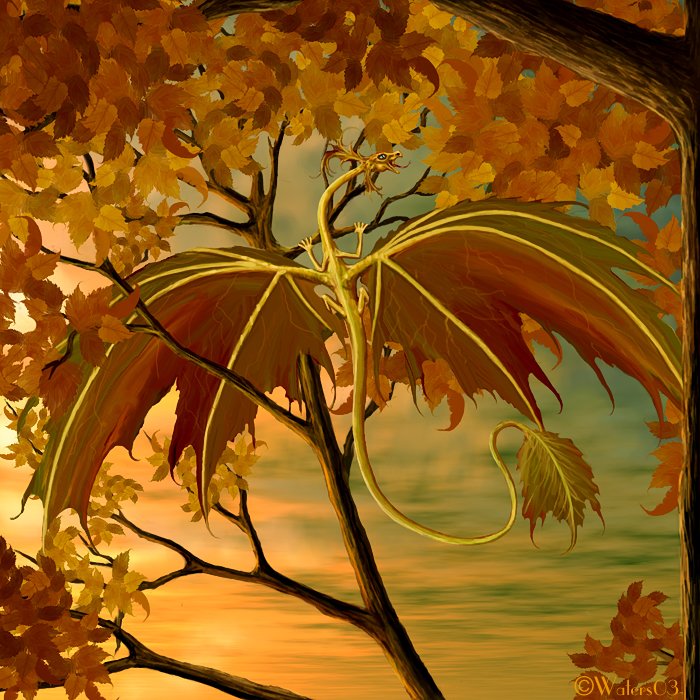
Notes
In general, dragons do not need
material components to cast
spells, and any somatic component of a
spell is modified or
deleted for dragon use.
First Level. Animal
friendship can seldom be used by a highly
egotistical dragon, for such creatures
are too self-centered to
wish to be friends with anyone, especially
not with mere
animals.
65
Charm avian is similar to Charm
person except that birds are
affected and speech is not necessary for
communication between
caster and charmee. Like Animal friendship,
Charm avian
is rarely used by highly egotistical dragons.
Use of the Identify
spell has no adverse affect on the dragon.
Dragons may use this spell even though
they can use virtually
no magic items.
Dragons which can Read
magic can cast spells from scrolls as
a master thief.
The Water to wine spell enables
the dragon to turn one barrel
of water into wine. A dragon able to do
this gains much status in
the eyes of other dragons.
Second Level. By means of the Alarm
spell a dragon can
enchant two large stones which, when placed
no more than 20
feet apart, act as an alarm system. if
any creature of higher than
animal intelligence moves between the
stones, a telepathic
warning sounds in the dragon’s mind, waking
it if it is asleep.
The spell must then be renewed. Duration
is seven days if the
alarm is undisturbed for that length of
time.
Fourth Level. When Wall of fire/ice
is rolled, choose the alternative
which is more appropriate considering
the dragon‘s
breath weapon and habitat.
The Seek spell enables the dragon
to track down those who
have wronged it. The spell cannot operate
unless one of the
following three conditions is fulfilled:
1) The dragon possesses an object previously
held or carried
for at least one hour by the creature
it is seeking.
2) The dragon knows the true full name
of the creature it is
seeking.
3) The dragon can remember the appearance
and sound of
voice (if any) of the creature it is seeking.
The spell then indicates the approximate
direction (within 10
degrees of the compass) and distance
(within 20%) of the creature
from the dragon’s location. The spell
must be cast again
each time another approximation is desired.
Fifth Level. Precognition gives
the dragon the ability to vaguely
see a possible future, exactly as a psionic
uses the precognition ability
(see Players Handbook).
One use of the spell allows one “look”
into the future.
See other
planes enables the dragon to look for one hour
upon events in some plane other than the
prime material. The
dragon may direct its gaze at a location
it has visited or which
has been described to the dragon in detail
by someone who has
seen it. Otherwise a random area is seen.
While gazing at other
planes the dragon is in a trancelike state.
Diet. Dragons
tend to eat large amounts at infrequent, irregular
intervals, and nothing in between. Their
biggest meals come
soon after long flights or long sleeps.
When desperate for food,
a dragon will eat almost anything,
but the table below is used to determine
the preferred diet of
each dragon. Naturally, plant eaters tend
to be less hostile to
humans and humanoids than meat eaters.
01-55 Fresh meat only
56-65 Meat (including carrion) only
66-95 Meat or plants (large bushes, trees)
96-00 Plants only
Habitat (optional).
Dragons may be found virtually anywhere.
There are seven ranges of conditions of
habitation. Roll d6,
counting a 6 as a 3, for each range on
a 1-5 scale. For example, a
1 on the hot/cold scale is very hot —
tropical or desert; a 3 is
temperate; a 5 is very cold — arctic or
Scandinavian. Roll for
each range separately. Seeming contradictions
can usually be
reconciled. For example, you may get very
hot, very dry, and
living on a seacoast. Deserts
do exist adjacent to the sea, however,
for example in Pakistan.
Ranges:
1. hot/cold
2. wet/dry
3. seacoast/inland
4. trees/treeless
5. flat/craggy
6. high altitude/low altitude
7. soil/rocky
Color. For unknown
reasons dragons bear an exaggerated,
almost mystical belief in the importance
of color. Only age is as
important in determining the dragon “pecking
order” or hierarchy
of respect and deference. There is a definite
preference
of color, in the order listed on the table
— every dragon wants a
golden offspring, every one dreads a gray.
Dragons choose their kings simply. In most
cases, the oldest
dragon of the color of highest priority
is king. Occasionally an
older dragon of less prominent color is
chosen. It is also possible
that a stupid king will be replaced by
a more intelligent
dragon of nearly similar age and color.
In any case, only lawful
dragons pay much attention to their kings.
For the neutral and
chaotic dragons, kingship is merely honorific.
Color:
| 01-05 | Gold |
| 06-10 | Silver |
| 11-15 | Bronze |
| 16-35 | Black |
| 36-55 | Red |
| 56-60 | White |
| 61-65 | Orange |
| 66-75 | Green |
| 76-80 | Purple |
| 81-90 | Brown |
| 91-00 | Gray |
Family. Dragons
are not prolific — only dragons of exactly 11
hit dice (101-200 years old) may conceive
young. The female is
in heat during only one week of each year,
so if she has no mate
or the mate is absent or asleep at that
time (dragons awaken one
another only when danger threatens), the
chance for conception
is lost. When a male is available to participate,
the chance of
conception during the week is only 5%.
Each litter is but a single
large egg which soon hatches, bringing
into the world a one-meter-
long baby dragon.
A dragon is protective of its offspring
and its mate, the latter
largely because he or she helps protect
the young. (Most dragons
are too self-centered to “love” any other.)
When offspring or
mate is in serious danger, a dragon attacks
at +4 to hit and adds 1
to each damage die for a maximum of four
melee rounds.
Interests. Dragons are very fond of stories
and of wine; they
fancy epic poetry in particular. Dragons
have been known to
keep storytellers or minstrels as pets
to entertain them. But most
of all, dragons like — they lust for —
gold. A dragon keeps the
location of its treasure hoard secret
against all blandishments,
even when charmed, and anyone found therein
is a fair target
even for the most lawful good dragon.
A dragon will pursue with
fanatical determination anyone who steals
from its hoard, provided
the remainder of the hoard is safely re-hidden.
Dragons
never forget a wrong (nor a right) done
to them.
As dragons age, they become less curious
about and interested
in human affairs. Roll 3d6 for each dragon
to determine its
basic interest and subtract its number
of hit dice. A zero or
negative result means that the dragon
will ignore humans except
in the most extraordinary circumstances
— for example,
when humans endanger the dragon’s life
or lair.
Dragons vary in alignment, just as men
do. Use the table on <Alignment>
page 100 of the Dungeon Masters Guide
to determine dragon
alignment. Usually, parents will beget
young of the same alignment;
cross-alignment matings are rare. In any
case, remember
that dragon-nature is stronger than alignment
in determining a
dragon’s actions. Alignment is a much
weaker force in a dragon
than in a human.
Lair. A dragon
is found in its lair 80% of the time.
The lair is
usually a spacious series of caves with
many twists, crevices,
and dead ends. Somewhere within lies the
dragon’s treasure
hoard, hidden with extreme care. When
in its lair, and only at
such times, a dragon can move silently
as a thief of a level equal
to the dragon’s hit dice (e.g. 5 dice
= fifth-level thief).
The closer a dragon is to its lair, the
more likely it is to be
hostile to anyone it meets in the vicinity
thereof. If the dragon is
disturbed while it sleeps in its lair,
it will almost certainly “shoot
first and ask questions later.” Dragons
have a highly developed
homing instinct. Regardless of where it
may be or how it got
there, the dragon knows in which direction
its treasure hoard
and lair lie.
01-501 Bronze Dragon of Pern
(Ral Partha)
Treasure.
The size of a dragon’s treasure hoard depends on its
hit dice. Several dragons in a lair will
each have their own
treasures hidden from the others. No more
than two dragons of
11 or more hit dice — a mated pair — will
be found in a single lair,
but there may be any number of younger
dragons, each with its
own treasure.
Dragon Treasure Table (HD = dragon’s hit dice)
| Copper | 10 x HD% 1-100 thousand, max. 10HD thousand |
| Silver | 10 x HD% 1-100 thousand, max. 10HD thousand |
| Electrum | 5 x HD% 1-20 thousand, max. 3HD thousand |
| Gold | 100% 1-10 thousand, max. 3HD thousand |
| Gems | 5 x HD% 1-6 (see below), max. 5HD gems |
| Jewelry | 4 x HD% 1(see below), max. HD jewelry |
| Magic items | 3 x HD% 1 (see below), max. ½HD items |
For gems, jewelry, and magic, keep rolling
until a negative
result (no further treasure in that category)
is rolled, or until the
maximum amount of treasure possible for
that category is
achieved. For example, a seven-dice dragon
has a 35% chance
of possessing 1-6 gems. Keep rolling percentile
dice until you
get a 36 or higher. The dragon has 1-6
gems for each roll of 35 or
less, up to a maximum total of 35 gems.
Sleep. The percentage
chance that a dragon will be asleep
when encountered is given on the table
at the beginning of this
article. Any disturbance will awaken a
dragon 8% of the time per
hit die. Some dragons aware of approaching
intruders will feign
sleep or pretend not to notice until an
opportune moment to
attack or capture the interloper.
A Dragon’s True
Name. A dragon’s True Name is its
most
prized possession. A dragon will never
reveal its True Name in
response to any threat. When its True
Name is spoken, there is a
5% chance that it will “hear” the Name
(even if the speaker is far
outside of normal hearing distance) and
know the direction and
distance
from the dragon of the place where it was spoken -- and
being protective of its Name, the dragon
may decide to investigate.
Some dragons have been known to entrust
the knowledge
of their Name to a friend, to be spoken
in a time of danger or
need; in such cases the dragon will always
hear and investigate,
for it will recognize its friend’s voice.
But dragon-friends are few
— you might not meet one in decades of
wandering, for only
those who do a great service for a dragon
of similar alignment to
them may become dragon-friends, and an
evil dragon rarely
entrusts its Name to anyone, regardless
of friendship.
A dragon cannot be charmed or held except
by one who
speaks the dragon’s True Name as he casts
the spell. If someone
says a dragon’s True Name directly to
the dragon within its
sight, the beast must grant one favor
or service to the speaker if
the speaker requests such. The dragon
will be thus coerced with
ill grace, and will later do all in its
power to avenge itself in
proportion to the nature of the favor
and the alignments of
dragon and speaker. For example, if the
speaker asks for the
dragon’s most precious treasure it must
oblige. But it will set out
24 hours later on the speaker’s trail
with fury and murder in
mind.
(Note: there are limits to what the dragon
will grant — it will
not risk its life, for example — and the
DM must be careful. If the
speaker does not immediately leave after
his favor has been
granted, the dragon is no longer under
compulsion to let him
leave peacefully. In other words, push
the dragon too far and it
may attack, True Name or no.)
Occasionally a dragon adopts a whimsical
“public” name
such as “Nose” or “Fiver,” but more often
they prefer to be
known only as “The Dragon” (“of such-and
such,” perhaps).
Dragon’s Curse.
Dragons cling tenaciously to life, as would
anyone who can live 500 years or more.
When a dragon receives
a death-blow, it lives long enough to
curse any one creature
which has contributed to its death. Usually
this will be the
creature which dealt the final blow. This
curse is similar to the
third-level clerical Curse but with no
range limitation and no
saving throw. The victim momentarily feels
as though a large,
cold hand has gripped his heart. A Dispel
magic spell may
remove the curse, but double the dragon’s
hit dice to determine
the efficiency level of the curse. For
example, if a sixth-level
cleric tries to dispel the dying curse
of a 12-dice dragon, he has a
14% chance (50 minus ( (24 -6) x 2) =
50 - 36 = 14%). Each person
is allowed but one try to dispel the curse.
A Remove curse spell
works in the same way as Dispel magic
for this curse.
A Dragon’s body.
Stories abound of heroes who have gained
courage, great strength, or invulnerability
through consuming a
dragon’s blood, heart, eyes, or other
parts. Certain sages, given
enough information, are able to work out
with reasonable accuracy
what parts of a particular dragon will
convey some virtue.
The part must be used within an hour of
the dragon’s death, for
thereafter the body dries into powder
or melts away. Those
without benefit of a sage’s analysis may
use body parts and take
their chances, but detrimental effects
are more common than
virtues. In any case, effects become apparent
only several hours
after consumption.
If a part is incorrectly used — for example,
if someone eats
bone powder — it either has no effect
or a harmful effect. “Eat”
means eat raw, not cooked. 10% of the
time a part will confer
some virtue on the “users,” 60% of the
time it will have no major
effect (though illness or discomfort may
result), and 30% of the
time it will cause harm.
Parts conferring virtue include scales/hide
(wear), bone
(powder and “bathe” in), eyes (eat), blood
(drink), blood (bathe
in), tongue (eat), guts (eat or bathe
in), heart (eat), and teeth
(powder and eat). The DM may, of course,
devise other methods
of use to confuse players, such as making
a stew with the heart.
Miscellaneous.
All dragons are able to speak dragonish. They <note that each species
has it's own language, in the DMG>
are able to learn one additional language
for each intelligence
point above 7.
All dragons are magical and consequently
register on Detect magic spells
and items. Dispel magic does not disturb them,
however.
Dragons never become diseased.
A highly egotistical dragon may be enticed
or deceived into
revealing the location of its mortal spot.
This is usually somewhere
on the belly. The spot is armor class
10; if hits equal to
10% or more of the dragon’s hit-point
total are inflicted on the
spot, the dragon dies immediately.
The less egotistical sort of dragon often
becomes a loremaster.
Astute humans sometimes consult such creatures
about
mysterious and ancient matters.
Meredragons.
A meredragon resembles a true dragon in appearance.
However, it is greatly inferior in power,
and it knows
and resents that fact. It may pretend
to be a true dragon, but will
never do so in the presence of one.
Mere dragons have low intelligence and
wisdom and are but
half the size of a true dragon; moreover,
they die when they
reach about 150 years of age. They cast
no spells, have no
special powers or breath weapon, and no
magic resistance.
They do have large egos,
however, and are often hostile because
they are annoyed that they aren’t true
dragons -- “unfair,”
they say, but never to a true dragon’s
face.
AGE:
TERROR:
SPECIAL POWER:
BREATH WEAPON:
SPELLS:
HABITAT:
COLOR:
35.
34.
33.
32.
31.
30.
29.
28. <20th anniversary: switch with 20>
27.
26.
25.
24.
23.
22.
21.
19.-20.
18.
17.
16.
15.
Edormira
Edormira
14.
13.
11.-12.
9-10.
7-8.
6.
5.
4.
3.
2.
1.
Original source = ?
